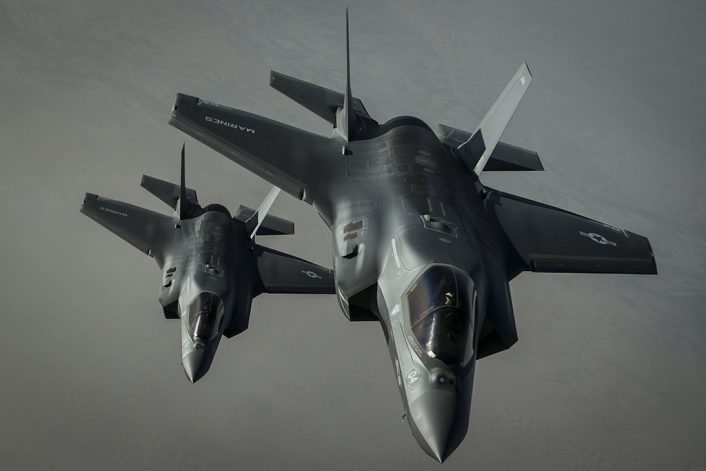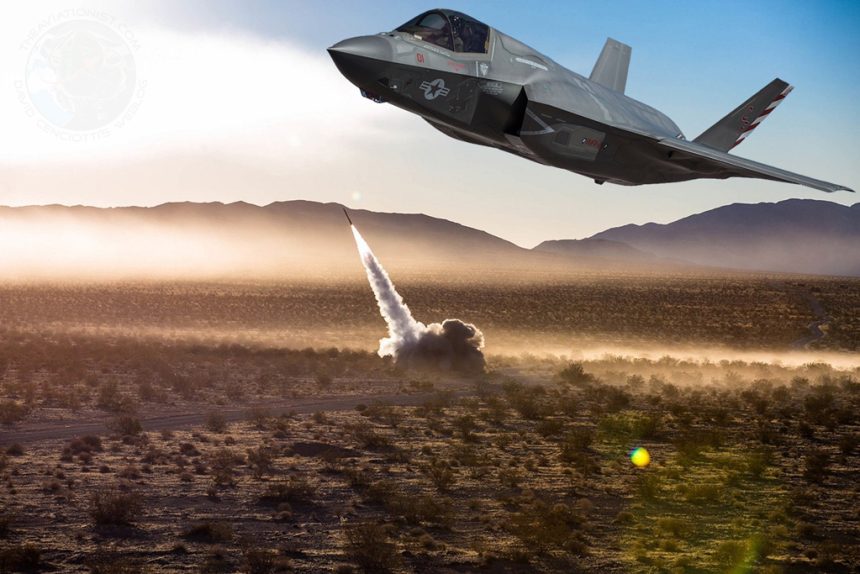Using Datalink, an F-35B shared target data with an M142 High Mobility Artillery Rocket System (HIMARS). 5th Gen. aircraft increasingly used to shorten the “sensor-to-shooter” cycle.
According to Lt. Gen. Steven R. Rudder, deputy commandant for aviation, the U.S. Marine Corps have achieved a milestone when a target was destroyed by connecting an F-35B Lightning II aircraft with a HiMARS rocket shot for the first time.
“We were able to connect the F-35 to a HIMARS, to a rocket shot … and we were able to target a particular conex box,” Rudder told audience members Friday at an aviation readiness discussion at the Center for Strategic & International Studies, or CSIS, Marine Corps Times reported.
The integration occurred during Marines’ latest weapons and tactics course at Yuma, Arizona: the F-35 gathered the target location using its high-end onboard sensors and shared the coordinates of the target to the HIMARS system via datalink in a “sensor to shooter” scenario. The HIMARS unit then destroyed the target.
The HIMARS is a movable system that can be rapidly deployed by air, using a C-130 Hercules. It carries six rockets or one MGM-140 ATACMS missile on the U.S. Army’s new Family of Medium Tactical Vehicles (FMTV) five-ton truck, and can launch the entire Multiple Launch Rocket System Family of Munitions (MFOM). In a typical scenario, a command and control post, a ship or an aircraft (in the latest test, an F-35B – the type that has just had its baptism of fire in Afghanistan) transmits the target data via a secure datalink to the HIMARS on-board launch computer. The computer then aims the launcher and provides prompt signals to the crew to arm and fire a pre-selected number of rounds. The launcher can aim at a target in just 16 seconds.
The Corps has been testing new ways to use its HIMARS lately. For instance, last fall, the Corps successfully fired and destroyed a target 70 km out on land from the deck of the amphibious transport dock Anchorage. Considered the threat posed to maritime traffic by cruise missiles fired by coastal batteries in the hands of terrorist groups and militias, the amphibious group’s ability suppress coastal defenses from long-range using artillery is important to allow Marines to come ashore.
The aim is clearly to shorten what is known as the sensor-to-shooter cycle – the amount of time it takes from when an enemy target is detected by a sensor – either human or electronic – and when it is attacked. Shortening the time is paramount in highly dynamic battlefield.

In September 2016, a live test fire demonstration involved the integration of U.S. Marine Corps F-35B from the Marine Operational Test and Evaluation Squadron (VMX 1), based in Edwards Air Force Base, with existing Naval Integrated Fire Control-Counter Air (NIFC-CA) architecture. The test was aimed at assessing the ability to shoot down incoming cruise missiles.
The F-35B acted as an elevated sensor (to detect an over-the-horizon threat as envisaged for the F-22) that sent data through its Multi-Function Advanced Data Link to a ground station connected to USS Desert Ship (LLS-1), a land-based launch facility designed to simulate a ship at sea. Using the latest Aegis Weapon System Baseline 9.C1 and a Standard Missile 6, the system successfully detected and engaged the target. Indeed, increasingly, 5th generation aircraft are seen as tools to provide forward target identification for both defensive and offensive systems (such as strike missiles launched from surface warships or submerged submarines). Back in 2013, PACAF commander Gen. Hawk Carlisle described the ability of advanced aircraft, at the time the F-22, to provide forward targeting through its sensors for submarine based TLAMs (Tomahawk Land Attack Missiles).
In the following years, the stealthy F-22s, considered “electronic warfare enabled sensor-rich multi-role aircraft”, saw their main role in the war on Daesh evolving into something called “kinetic situational awareness”: in Syria and Iraq, the Raptors escorted the strike packages into and out of the target area while gathering details about the enemy systems and spreading intelligence to other “networked” assets supporting the mission to improve the overall situational awareness. To make it simple, during Operation Inherent Resolve, the 5th generation aircraft’s pilot leverages advanced onboard sensors, as the AESA (Active Electronically Scanned Array) radar, to collect valuable details about the enemy Order of Battle, then shares the “picture” with attack planes, command and control assets, as well as Airborne Early Warning aircraft, while escorting other manned or unmanned aircraft towards the targets. Something the F-35 will also have to do in the near future.
Top image: “artwork” made using USMC images









